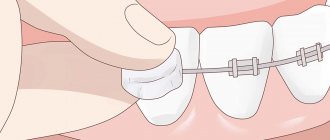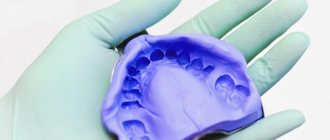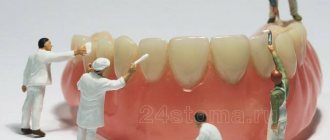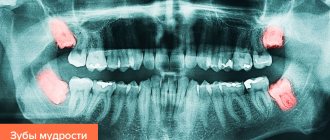Prosthetics allows you to restore the functionality and aesthetics of the dentition. After installing a fixed denture, patients experience a certain discomfort, which quickly passes, and the new teeth are quickly perceived as their own. With removable dentures, more serious problems arise, including a gag reflex and the inability to wear them every day.
Adaptation to dentures is an individual process: for some it takes only a few days, while for others it drags on for several months. We'll tell you how to quickly get used to dentures.
Dry mouth or increased salivation
A feeling of dryness or, on the contrary, increased salivation occurs due to the adaptation of the mucous membranes to a foreign body. If the design is made correctly, the discomfort quickly passes. If your mouth is dry, you should drink water more often and rinse, but do not use alcohol solutions. It is worth limiting the consumption of tea, coffee, and at least temporarily giving up smoking. You need to get rid of dryness quickly, otherwise your gums will be injured.
Excessive salivation is a reaction to a foreign body in the mouth, to constant contact with the mucous membrane. It goes away on its own in a few days. You can simplify the adaptation process for the mucous membrane by rinsing with decoctions of chamomile, oak bark or sage, or solutions recommended by your doctor.
Adaptation to dentures
On average, getting used to the prosthesis takes about 4 weeks. This period largely depends on the type of prosthesis. Thus, a plate product made of hard plastic provokes rubbing of the gums due to its rigidity and requires a long period of getting used to, up to 6 months. Acrylic and clasp dentures will require 2-3 months to get used to. Nylon constructions, quadrotti and acrifi have the shortest adaptation period of only 1-4 weeks.
The period of adaptation to the prosthesis occurs in 3 phases :
- Location phase (5 days). The prosthesis is perceived as a foreign body: it interferes with normal chewing of food and speaking. A lot of saliva is produced.
- Primary inhibition phase (5-7 days). The production of saliva is normalized, the lisp disappears, and discomfort remains when chewing food.
- Full braking phase. Discomfort is noted during removal of the prosthesis from the oral cavity.
It is possible to develop intolerance to orthodontic products with the following manifestations:
- burning, erythema in the mouth;
- soreness of the oral mucosa;
- loss of taste;
- metallic or plastic taste when eating.
This condition most often develops when there is an allergy to the materials from which the prosthesis or its components are made. This may also indicate that the prosthesis does not fit correctly.
Problems with diction
After prosthetics, there is less space in the mouth, which is why the patient may have problems with diction at first: the tongue does not have enough free space, sounds are distorted. To cope with this faster, you will need training. To do this, you can read aloud, pronounce individual complex sounds, and do tongue exercises. The more actively the tongue “works” immediately after prosthetics, the faster the adaptation will take place and normal diction will be restored. When getting used to speaking correctly, you need to make sure that when pronouncing sounds, saliva does not fly from your mouth. A good workout would be tongue twisters that are spoken slowly, making sure that the pronunciation and articulation are correct.
Caring for a removable denture
Proper care of the prosthesis is the key to the fastest possible adaptation. For those people who have previously carefully cared for their oral cavity and teeth, the process of caring for a denture will not become something scary and overly intrusive. You just need to learn a few simple rules:
- Rinse your mouth after every meal. It would also be a good idea to rinse the structure itself. Simply remove it from your mouth and rinse thoroughly under running water;
- Every morning, the denture must be cleaned with a brush and a special paste. Each type of prosthesis has its own accessories, which are selected separately. During the cleaning process, special attention should be paid to the inside of the prosthesis, this is where a huge number of different microorganisms accumulate, and food particles also become clogged. Otherwise, they can cause severe gum inflammation.
- Additional disinfection is still necessary. To carry it out, you will need to purchase some additional funds. In most cases, these are ointments or effervescent tablets, into the solution of which the prosthesis is dipped.
Some products for the care of dentures
Read about dental prosthetics in St. Petersburg in the article.
Moscow metro station Zvezdnaya, Danube Avenue, 23
Eating
Chewing skills with a newly installed denture need to be developed gradually. This does not mean that you need to switch to broths, purees and cereals. On the contrary, you need training with a gradual increase in load. The hardness of the products is increased gradually. It is better to start eating vegetables and fruits in small pieces, chewing them thoroughly. They get used to biting food in the same way - gradually, starting with softer foods and moving on to hard foods. You need to chew and bite carefully: it is important not to damage or injure the gums, and to control the load on it.
After installing a removable denture, the patient may feel that food is deprived of its usual taste, it has become less pronounced. This occurs because the base of the structure covers the palate where the tactile receptors are located. This does not affect the perception of taste in any way - taste buds are located on the tongue. The feeling that the taste of food has changed is associated with a foreign body in the mouth and quickly passes as you get used to it.
Do you have questions about removable dentures?
We will call you back within 30 seconds
+7
Terms of the adaptation period
In 90% of cases, patients feel discomfort after prosthetics. The time it takes to get used to dentures depends on many factors, so in some patients the discomfort goes away quickly, while in others it lasts for a long period.
It is difficult to talk about the exact timing of adaptation. Several criteria should be noted on which the adaptation time depends: the degree of fixation of the structure in the oral cavity, the condition of the patient’s periodontal tissues and his reactions to the denture material. The period of adaptation increases if the structure is not securely fixed in the oral cavity. Recovery time after prosthetics increases in patients who had periodontal damage at the time of the procedure.
A long period of adaptation is observed in people after the installation of bulge dentures. This is due to the fact that the design contains metal elements that have a negative effect on the soft tissues of the mouth.
How long does it take for addiction to occur? In many ways, the adaptation period also depends on the moral state of the patient. People who try to remove the system at every opportunity or experience psychological discomfort from wearing products are more likely to suffer from complications after prosthetics.
Let's consider other factors that prolong recovery time after prosthetics:
- Insufficient fixation of the product on the dentition.
- Thinning of the jaw structures, which develop due to a person’s long-term refusal to use prosthetics. Many people are in no hurry to immediately restore lost units and in the future face even greater problems with bite and atrophy of the bone structures of the jaw.
- Abnormal structure of the dental system.
- Inconsistency of artificial teeth in shape and size with the patient.
Injuries
In the first days after installation, injured areas may appear on the surface of the gums: small wounds, abrasions, etc. They may appear due to improper chewing technique or sensitivity of the mucous membrane. Normally, the denture stops rubbing the gums within a few days. You can speed up this process by rinsing with antiseptic solutions and chamomile decoction.
If injuries do not go away over time, become more pronounced, or cause increasing discomfort, you should consult a doctor. The problem may lie in the design itself. The doctor will conduct an examination and correct the prosthesis. Usually one correction is enough for the discomfort to go away.
Treatment methods
You can soothe inflamed areas of soft tissue with the help of medicinal oils, for example, rose hips or sea buckthorn. Pharmacies also sell special collagen plates and pads, which are designed specifically to protect the mucosa and facilitate adaptation to removable orthopedic structures. Creams and gels for stimulating tissue healing have proven themselves to be excellent in this regard. But in any case, with the problem, you need to contact your attending physician, who will be able to determine the tactics of further treatment and understand whether the design needs to be adjusted or the use of medications will be sufficient.
Relining the denture In the process of constantly wearing a removable denture, the bone tissue of the jaws gradually atrophies, which causes the gums to recede. As a result, the design may cause some discomfort, but the procedure of relining the prosthesis, that is, its correction, will help to cope with the problem. True, it will have to be carried out regularly, since the level of the alveolar ridge will constantly change.
Price:
from 1000 rubles more about the solution
Making a new prosthesis If the orthopedic structure begins to rub due to breakage, the creation and installation of a new one will be required. Manufacturing can take from 3-4 days to a couple of weeks. During fitting, it is important for the patient to carefully listen to his feelings, as well as evaluate how comfortable the new design is. If discomfort is felt, the prosthesis should be sent for re-adjustment and adjustment to the desired parameters.
Price:
from 15,000 rubles more about the solution
Implantation with immediate loading Modern one-stage methods of dental implantation require immediate loading with a prosthesis. In addition, these treatment protocols in most cases make it possible to avoid bone grafting or sinus lifting in the upper jaw. Complex dental restoration with complete or almost complete edentia can be carried out using 3, 4, 6 or even 12 implants. In any case, the prosthesis is installed on the 3rd day maximum, which allows the patient to fully smile and eat almost immediately. Unlike removable prosthetics, a design supported by implants lasts longer, it is much more comfortable, and does not cause discomfort or chafing of the mucous membrane at all.
Price:
from 180,000 rubles / 1 jaw more about the solution
Allergic reaction
It occurs very rarely, since all structural elements are made of hypoallergenic, biocompatible materials. It manifests itself as redness of the gums at the contact site; this area may itch and possibly burn. The unpleasant sensations do not go away and do not weaken, they can intensify, the gums look injured.
Allergy is a rejection of construction materials, which may be accompanied by nausea, malaise, and dizziness. It appears almost immediately after installation, disappears after some time if you remove it. There is no point in waiting for adaptation in case of allergies - the reaction will only intensify over time. To solve the problem, you need to find out which material in the structure you are allergic to and make a new prosthesis without using it.
Soreness
Most often, patients complain of pain and pressure on soft tissues. This phenomenon is observed when soft tissues are unaccustomed to stress and begin to hurt not only when chewing, but also at other times. Many people start taking painkillers as the only way to alleviate the condition. In addition to medications, which are needed only at first, it is recommended to change the diet and eliminate solid foods. It takes about a month to adapt, after which the pain stops bothering you. If the discomfort lasts longer, you should definitely see a doctor.
One option to reduce pain is gum massage. To do this, follow these simple steps:
- wash your hands with any soap with antibacterial properties;
- the prosthesis is removed, the gums should be stroked with gentle circular movements, gradually touching the inflamed area;
- the pressure gradually increases, you need to start making vertical movements.
The duration of exposure is three to four minutes, after which the pain decreases. It is recommended to do massage not only during the period of adaptation, but also constantly, improving blood circulation in the tissues, eliminating the risks of developing inflammation.
Psychological aspect
Often the use of a prosthesis provokes psychological discomfort in the patient: it frightens him, it seems to him that complications have already arisen, and adaptation is not going well. To prevent such a problem from arising, you need the right attitude: a person must be prepared for the difficulties that may arise in the first days. It is important to take your time and understand that the body needs to get used to new conditions. The period of complete adaptation takes up to one and a half months on average, but the most noticeable discomfort disappears after 1-2 weeks if you wear the prosthesis constantly.
To get used to a removable denture faster, orthodontists at the Dentospas clinic recommend massaging the gums. You can do it yourself, it will improve blood circulation and tissue nutrition, and improve the condition of the gums. Massage is done provided that the surface of the mucous membrane is not injured and there are no open wounds on it. At first, to speed up adaptation, you can leave the prosthesis on at night (install it again after cleaning). This is safe (the gums and tongue hardly move during sleep) and allows you to increase the time of contact of the mucous membrane with the base of the structure.
Reasons for the inconvenient placement of the prosthesis
The main reasons for the appearance of severe discomfort while wearing an orthopedic system include the following factors:
- psychological unpreparedness of the patient for dentures,
- incorrectly manufactured design,
- initially inflamed gums, which were not treated,
- poor hygienic care of the structure and the entire oral cavity,
- features of the condition of the temporomandibular joint,
- uneven relief of the alveolar ridge.











